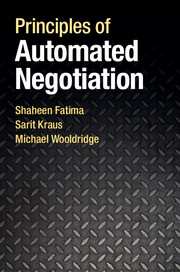Book contents
- Frontmatter
- Dedication
- Contents
- List of illustrations
- Preface
- Acknowledgements
- Summary of key notation
- 1 Introduction
- 2 Games in normal form
- 3 Games in extensive form
- 4 Negotiation domains
- 5 Strategic analysis of single-issue negotiation
- 6 Strategic analysis of multi-issue negotiation
- 7 The negotiation agenda
- 8 Multilateral negotiations
- 9 Heuristic approaches
- 10 Man–machine negotiations
- 11 Axiomatic analysis of negotiation
- 12 Applications
- 13 Related topics
- 14 Concluding remarks
- Appendix A Proofs
- References
- Index
3 - Games in extensive form
Published online by Cambridge University Press: 05 November 2014
- Frontmatter
- Dedication
- Contents
- List of illustrations
- Preface
- Acknowledgements
- Summary of key notation
- 1 Introduction
- 2 Games in normal form
- 3 Games in extensive form
- 4 Negotiation domains
- 5 Strategic analysis of single-issue negotiation
- 6 Strategic analysis of multi-issue negotiation
- 7 The negotiation agenda
- 8 Multilateral negotiations
- 9 Heuristic approaches
- 10 Man–machine negotiations
- 11 Axiomatic analysis of negotiation
- 12 Applications
- 13 Related topics
- 14 Concluding remarks
- Appendix A Proofs
- References
- Index
Summary
While normal-form games capture the strategic structure of decision-making settings, they abstract away one key aspect of playing games that seems quite central to their character. Specifically, they assume that players make choices and act simultaneously, with no knowledge of the choices of their counterparts. But in many strategic situations, the players do not move simultaneously: they take turns in making their moves. An obvious example of such a situation is the game of chess. Another example is a bargaining scenario where a buyer and a seller take turns in making offers to each other in order to reach an agreement on the price of a commodity. Such situations may be modelled using sequential-moves games. In this chapter, we will study how these games are represented, and what notions of equilibria are used to analyse and solve them.
In a purely sequential-moves game, the players not only take turns in making their moves, but they typically know what the players did in all the previous moves. In contrast, when a player makes a move in a simultaneous-moves game, he does not know the other players' moves.
Purely sequential-moves and purely simultaneous-moves situations rarely arise in practice; many interesting real-world situations involve both simultaneous and sequential moves. Thus, we will learn how to model such situations with games and how to analyse and solve those games.
- Type
- Chapter
- Information
- Principles of Automated Negotiation , pp. 35 - 55Publisher: Cambridge University PressPrint publication year: 2014



